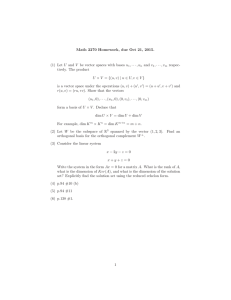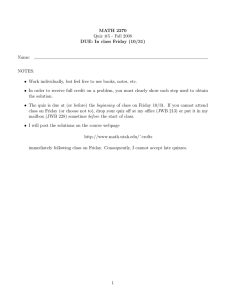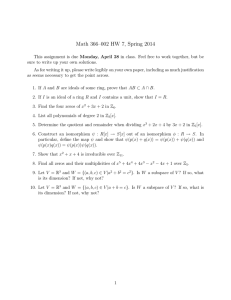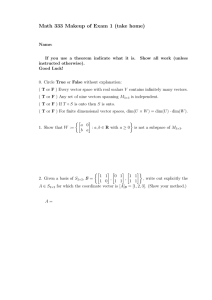Problem 1. Let V be a finite dimensional vector space over a field F
advertisement
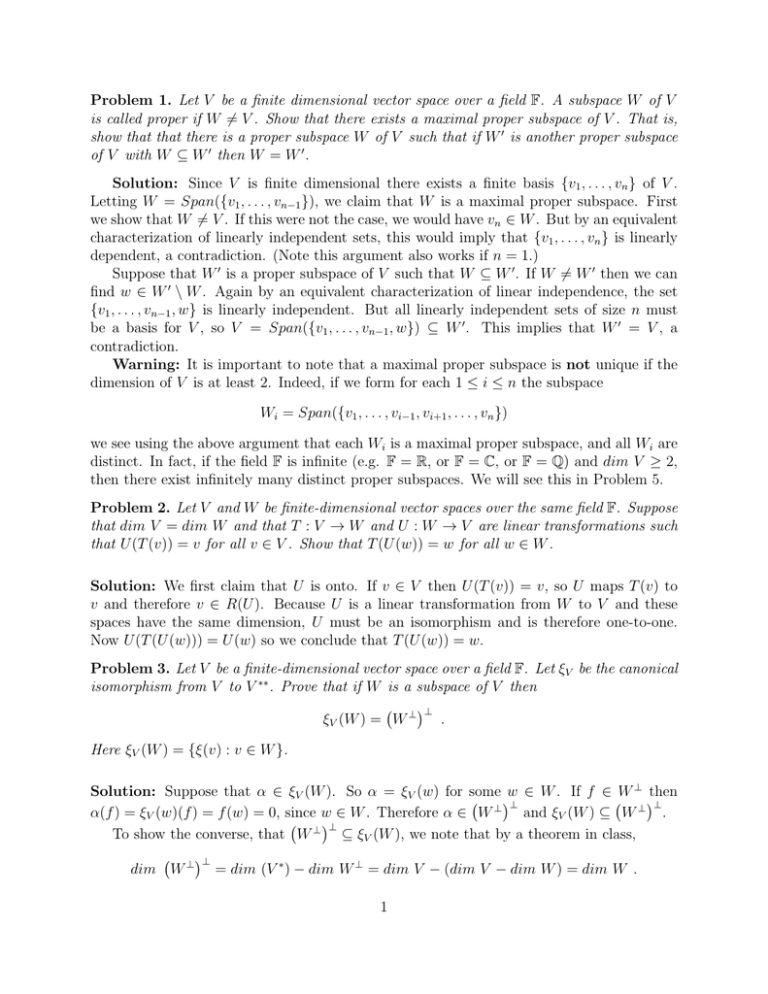
Problem 1. Let V be a finite dimensional vector space over a field F. A subspace W of V
is called proper if W 6= V . Show that there exists a maximal proper subspace of V . That is,
show that that there is a proper subspace W of V such that if W 0 is another proper subspace
of V with W ⊆ W 0 then W = W 0 .
Solution: Since V is finite dimensional there exists a finite basis {v1 , . . . , vn } of V .
Letting W = Span({v1 , . . . , vn−1 }), we claim that W is a maximal proper subspace. First
we show that W 6= V . If this were not the case, we would have vn ∈ W . But by an equivalent
characterization of linearly independent sets, this would imply that {v1 , . . . , vn } is linearly
dependent, a contradiction. (Note this argument also works if n = 1.)
Suppose that W 0 is a proper subspace of V such that W ⊆ W 0 . If W 6= W 0 then we can
find w ∈ W 0 \ W . Again by an equivalent characterization of linear independence, the set
{v1 , . . . , vn−1 , w} is linearly independent. But all linearly independent sets of size n must
be a basis for V , so V = Span({v1 , . . . , vn−1 , w}) ⊆ W 0 . This implies that W 0 = V , a
contradiction.
Warning: It is important to note that a maximal proper subspace is not unique if the
dimension of V is at least 2. Indeed, if we form for each 1 ≤ i ≤ n the subspace
Wi = Span({v1 , . . . , vi−1 , vi+1 , . . . , vn })
we see using the above argument that each Wi is a maximal proper subspace, and all Wi are
distinct. In fact, if the field F is infinite (e.g. F = R, or F = C, or F = Q) and dim V ≥ 2,
then there exist infinitely many distinct proper subspaces. We will see this in Problem 5.
Problem 2. Let V and W be finite-dimensional vector spaces over the same field F. Suppose
that dim V = dim W and that T : V → W and U : W → V are linear transformations such
that U (T (v)) = v for all v ∈ V . Show that T (U (w)) = w for all w ∈ W .
Solution: We first claim that U is onto. If v ∈ V then U (T (v)) = v, so U maps T (v) to
v and therefore v ∈ R(U ). Because U is a linear transformation from W to V and these
spaces have the same dimension, U must be an isomorphism and is therefore one-to-one.
Now U (T (U (w))) = U (w) so we conclude that T (U (w)) = w.
Problem 3. Let V be a finite-dimensional vector space over a field F. Let ξV be the canonical
isomorphism from V to V ∗∗ . Prove that if W is a subspace of V then
⊥
ξV (W ) = W ⊥
.
Here ξV (W ) = {ξ(v) : v ∈ W }.
Solution: Suppose that α ∈ ξV (W ). So α = ξV (w) for some w ∈ W . If f ∈ W ⊥ then
⊥
⊥
α(f ) = ξV (w)(f ) = f (w) = 0, since w ∈ W . Therefore α ∈ W ⊥ and ξV (W ) ⊆ W ⊥ .
⊥
To show the converse, that W ⊥ ⊆ ξV (W ), we note that by a theorem in class,
dim W ⊥
⊥
= dim (V ∗ ) − dim W ⊥ = dim V − (dim V − dim W ) = dim W .
1
Furthermore we claim that dim ξV (W ) = dim W . This would imply that the spaces ξV (W )
⊥
⊥
and W ⊥ are equal because they have the same dimension and ξV (W ) ⊆ W ⊥ . We
can view ξV as a linear transformation ξV |W from W to ξV (W ) and apply the rank-nullity
theorem. Then dim ξV (W ) = dim R(ξV |W ) = dim W −dim N (ξV |W ). Since ξV is one-to-one,
so is ξV |W and thus dim N (ξV |W ) = 0, so this completes the proof.
Problem 4. Let V be a finite-dimensional vector spaces over a field F and fix φ ∈ L(V, V ).
Define Φ : L(V, V ) → L(V, V ) by
Φ(T ) = T ◦ φ ,
where T ◦ φ is the composition map: (T ◦ φ)(v) = T (φ(v)) for all v ∈ V . Is it possible that
the nullity of φ is 3 and the nullity of Φ is 7? If so, give an example; otherwise, prove that
it is impossible.
Solution: We claim that the nullity of Φ equals the nullity of φ times the dimension of V .
Since the dimension of V is an integer and 7 is not a multiple of 3, this implies that it is not
possible to have the dimensions of N (φ) and N (Φ) be 3 and 7 respectively.
To show this, we first show that
N (Φ) = {T ∈ L(V, V ) : T (v) = ~0 for all v ∈ R(φ)} .
e . Let T ∈ N (Φ), so that T ◦ φ(v) = ~0 for all v ∈ V . If v ∈ R(φ)
Call the right side above N
then v = φ(u) for some u ∈ V . Then we have
T (v) = T (φ(u)) = T ◦ φ(u) = ~0 .
e . Conversely, if T ∈ N
e then T (v) = ~0 for all v ∈ R(φ). If u ∈ V then
Therefore T is in N
φ(u) ∈ R(φ), so
T ◦ φ(u) = T (φ(u)) = ~0 .
Therefore T ∈ N (Φ).
e . To do this, let {v1 , . . . , vk , . . . , vn } be a basis for
Now we calculate the dimension of N
V such that {v1 , . . . , vk } is a basis for R(φ). Let Ve be the span of the vectors vk+1 , . . . , vn .
e is isomorphic to L(Ve , V ). Once we prove this, we will have
We claim that N
e = dim L(Ve , V ) = (n − k)n = dim N (φ) × n .
dim N
The last equality follows from the rank-nullity theorem, applied to φ.
e to L(Ve , V ) is simply the restriction map. For T ∈ N
e,
The isomorphism we define from N
define Ψ(T ) ∈ L(Ve , V ) as the unique linear transformation that satisfies
Ψ(T )(vi ) = T (vi ) for i = k + 1, . . . , n .
This is possible because a linear transformation is uniquely specified by its values at a basis.
e . Then T (vi ) = U (vi )
To show that Ψ is one-to-one, suppose that Ψ(T ) = Ψ(U ) for T, U ∈ N
2
e we also have T (vi ) = ~0 = U (vi ) for
for i = k + 1, . . . , n. But since these maps are in N
i = 1, . . . , k, so they have the same values at each basis element of V . This implies that
e by its values on the
T = U . To show Ψ is onto, take T 0 ∈ L(Ve , V ). Then define T ∈ N
0
basis of V : T (vi ) = ~0 for i = 1, . . . , k and T (vi ) = T (vi ) for i = k + 1, . . . , n. Clearly now
Ψ(T ) = T 0 .
e and c ∈ F . Then for each i = k + 1, . . . , n,
Last Ψ is linear. To see this, let T1 , T2 ∈ N
Ψ(cT1 + T2 )(vi ) = (cT1 + T2 )(vi ) = cT1 (vi ) + T2 (vi )
= cΨ(T1 )(vi ) + Ψ(T2 )(vi ) = (cΨ(T1 ) + Ψ(T2 ))(vi ) .
Since the maps Ψ(cT1 + T2 ) and cΨ(T1 ) + Ψ(T2 ) agree on the basis of Ve , they must be the
same transformation.
Problem 5. Let V be a finite-dimensional vector space over C. Is it possible to find finitely
many proper subspaces W1 , . . . , Wk of V such that
k
[
V =
Wi ?
i=1
(Recall the definition of a proper subspace from problem 1: it is a subspace W such that
W 6= V .)
S
Warning: It is important to note that the symbol
denotes the union of subspaces.
This is very different from their sum.
Solution: The answer is negative. We will argue by induction on n, the dimension of V .
If n = 1 then the only proper subspace of V is the zero subspace and any union of proper
subspaces must therefore be equal to this. Since {~0} is not equal to V this completes the
case n = 1.
Assume now that for some n ≥ 2, no vector space of dimension n − 1 can be written as
a union of finitely many of its proper subspaces. We will show this is also true for n. For
this, let V be a vector space of dimension n over C and suppose, by way of contradiction,
that there exist finitely many proper subspaces of V , called W1 , . . . , Wk , such that
V =
k
[
Wi .
(1)
i=1
The strategy now is to find an n − 1 dimensional subspace of V , which we will call W ,
such that W is not equal to any of the Wi ’s. Let us assume that we have succeeded in doing
that and see how this would solve the problem. Intersecting both sides of Equation (1) with
W we obtain
k
[
W = (W ∩ Wi ) .
i=1
3
We claim that, for each i, W ∩ Wi is a proper subspace of W . Indeed, if it were not, then
we would have W ∩ Wi = W , which implies W ⊆ Wi . But W has dimension n − 1 and Wi
has dimension at most n − 1 (since it is a proper subspace of V ), from which we conclude
W = Wi . This contradicts the assumption that W is not equal to any of the Wi , and the
claim that W ∩ Wi is a proper subspace of W is shown. Applying the inductive hypothesis
to W we arrive at a contradiction, and the solution of the problem is complete.
We have just shown that finding a subspace W ⊂ V of dimension n − 1 which is not
equal to any of the Wi is enough to solve the problem. We will now show how to find this
subspace. Choose a basis v1 , . . . , vn of V . For each nonzero c ∈ C define the subset of V
Sc = {z1 v1 + . . . + zn vn |zi ∈ C, z1 + · · · + zn−1 + czn = 0} .
It is not hard to check that for each c, Sc is an n − 1 dimensional subspace of V . We claim
that for c 6= d, the subspaces Sc and Sd are not equal. Indeed, the vector cv1 − vn belongs to
Sc but not to Sd . This means that the collection of subspaces (Sd ) contains infinitely many
distinct subspaces of V of dimension n − 1. This is due to the fact that C is infinite (in fact,
this proof works for any infinite field, not just C). Because there are only finitely many Wi ’s,
at least one of the spaces Sc must not be equal to any of the Wi ’s. We can choose this as W .
4


